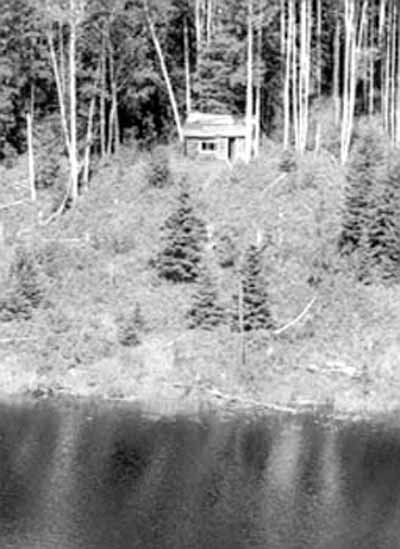Anahareo's Cabin, Building 35
Recognized Federal Heritage Building
Prince Albert National Park of Canada, Saskatchewan

Exterior photo
(© (Parks Photo Services, 1932-40.))
Address :
Twp. 59, Range 4, Waskesiu - Ajawaan Lake, Prince Albert National Park of Canada, Saskatchewan
Recognition Statute:
Treasury Board Policy on Management of Real Property
Designation Date:
1988-05-05
Dates:
-
1979 to 1979
(Significant)
Custodian:
Parks Canada
FHBRO Report Reference:
85-63
DFRP Number:
14567 00
Description of Historic Place
Anahareo’s Cabin is located on a hillside above Grey Owl’s Cabin and overlooking Ajawaan Lake in Prince Albert National Park. The simple, rustic cabin has a gable roof and is constructed of horizontal logs. The designation is confined to the footprint of the building.
Heritage Value
Anahareo’s Cabin is a Recognized Federal Heritage Building because of its historical associations, and its architectural and environmental values.
Historical Value:
Anaharoe’s Cabin is one of the best examples of a building associated with Anahareo, who was the second wife of the naturalist Archibald Belaney, more commonly known as ‘Grey Owl’. Grey Owl achieved international fame through his wildlife films, writings and lecture tours. The designation of this upper cabin, in memory of Grey Owl’s wife, recognizes widespread public fascination with the personal life of Grey Owl.
Architectural Value:
Anahareo’s Cabin is an example of rustic construction in the log cabin tradition. Though it was extensively reconstructed in 1979, the simple form, materials and detailing reflect the original cabin in its economy of design and rustic aesthetics. The use of natural textures and finishes and local materials result in a building that suits its wilderness setting. The building exhibits good craftsmanship and materials.
Environmental Value:
Anahareo’s Cabin maintains an unchanged relationship to its site, is compatible with the undeveloped, natural character of its lakeside setting and is a familiar attraction for park visitors.
Sources:
Edward Mills, Buildings, Prince Albert National Park Volume 2, Federal Heritage Buildings Review Office Report 85-063.
Anahareo’s Cabin, Ajawaan Lake, Prince Albert National Park, Saskatchewan, Heritage Character Statement 85-063.
Character-Defining Elements
The character-defining elements of Anahareo’s Cabin should be respected, for example:
Its good quality craftsmanship and natural materials, for example:
Its horizontal log construction and shingled roof. The use of local native materials, natural in colour and rough in texture. The placement of the wood windows and the wood panel door.
The manner in which Anaharoe’s Cabin maintains an unchanged relationship to its site, is compatible with the present rustic character of its natural park setting, and is a familiar building in the park, as evidenced by:
The cabin’s ongoing relationship to the forest in which it is situated. The simple form, natural materials and textures of the cabin that are compatible with its natural surroundings. Its association with Grey Owl and with aspects of his personal and professional life that make it an attraction known to visitors and townspeople.
Heritage Character Statement
Disclaimer -
The heritage character statement was developed by FHBRO to explain the reasons for the designation of a federal heritage building and what it is about the building that makes it significant (the heritage character). It is a key reference document for anyone involved in planning interventions to federal heritage buildings and is used by FHBRO in their review of interventions.
Anahareo's Cabin was constructed in 1932 by Park staff. It was extensively reconstructed in 1979. Parks Canada is the custodian. See FHBRO Building Report 85-63.
Reason for Designation
Anahareo's Cabin was designated Recognized because of its historical associations, its environmental and local significance, and its architectural interest.
Anahareo was the second wife of naturalist Archibald Belaney, who was known as Grey Owl. Grey Owl achieved international fame as a conservationist through his wildlife films, writings and lecture tours. The designation of this upper cabin in memory of Grey Owl's wife recognizes widespread public fascination with the personal life of Grey Owl.
The cabin is located on a hillside above Grey Owl's cabin. Together, they are familiar to park visitors. The undeveloped natural setting has been maintained.
Anahareo's Cabin is an example of rustic construction in the log cabin tradition. The simple form, materials and detailing reflect an economy of design in keeping with that tradition. The use of natural textures and finishes and local materials results in a building that harmonizes with its surroundings.
Character Defining Elements
The heritage character of Anahareo's Cabin resides in the building's form, its overall proportions, in its construction materials and details, in its surviving interior layout, and in its relationship to the site and setting.
The cabin is a rectangular one-storey gable-roofed structure. The simple form, footprint and roofline should not be altered, as they are essential to the rustic quality which characterizes the cabin.
The natural materials and textures should be respected, and any new work should be compatible in material, detailing and level of finish. The reconstruction in 1979 involved replacement of the lower part of the walls and the log footings, and complete replacement of the wood shingle roof in keeping with the earlier configuration. Research is recommended to confirm the color and profile of original log chinking and/or daubing when this work requires renewal. The building materials merit regular inspection and maintenance. Any new work should respect the rustic character of the original construction.
The wood windows and the wood panel door are in keeping with the character of the building and should be maintained. The location of the windows and doors is governed by function, reflecting the informal quality of the cabin's appearance, and should not be altered.
The natural, undeveloped character of the site and of site access enhances the rustic qualities of the building and should be maintained.